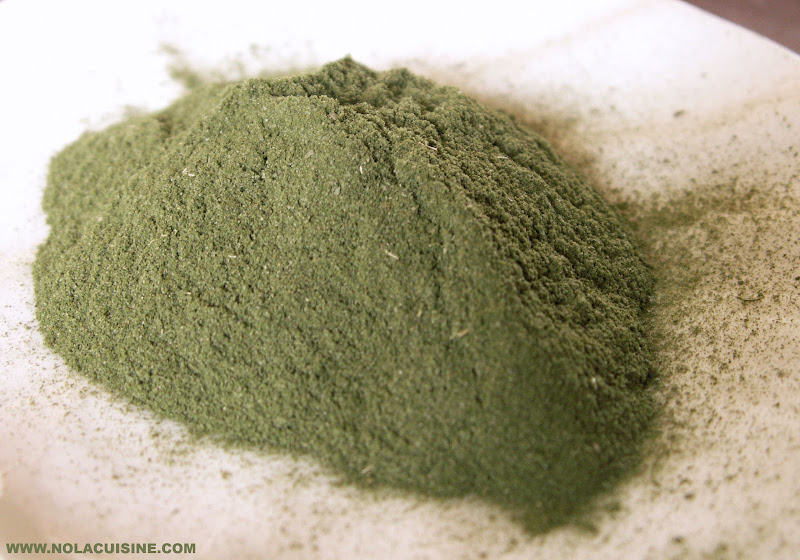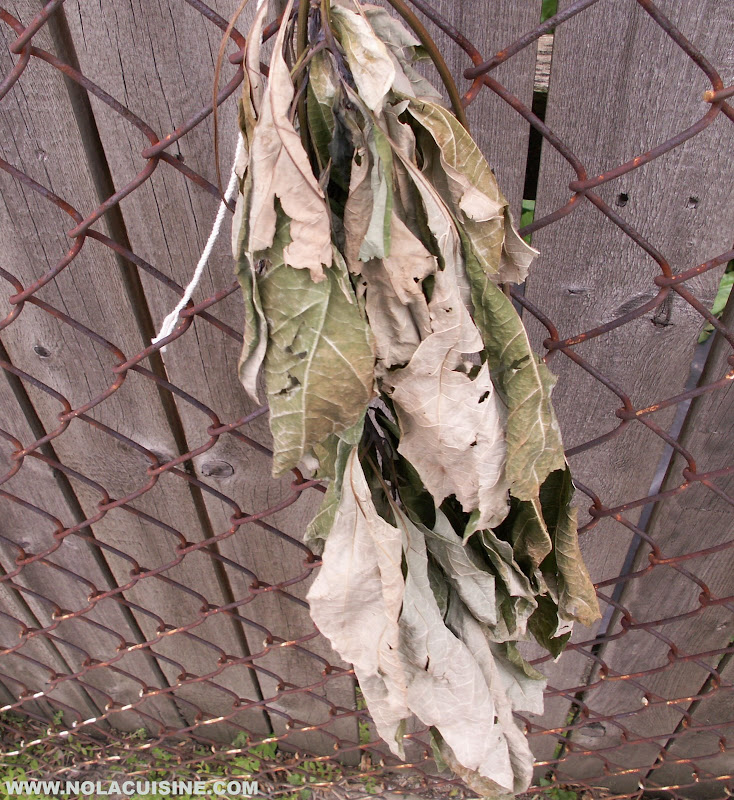Homemade Filé Powder / NOLA
The following is from the 1978 book Creole Gumbo and All That Jazz by Howard Mitcham [3] :
:
The Story of Filé
Posted By Danno On July 3, 2006 @ 2:05 pm In Articles,Recipes
I finally made a small batch of homemade Filé Powder, and I can’t believe the difference between the true Filé and the store bought variety.
The Filé that I made smells subtle and fruity like coriander seeds, or as my wife said, “Fruit Loops.” It’s color as you can see, is army green, and I’m assuming that it’s thickening power is way more intense than the store bought, which I’ve noticed has zero thickening power at all, and has a flavor that can almost take over the flavor of your Gumbo.
The store bought Filé smells very woodsy, and you can detect some thyme and possibly some bay leaf in there, it’s color is tan. One that I saw recently contained Sage, Oregano, and Thyme, and no Sassafras at all. There are definately some good ones out there, but definately some really bad ones. For example, here is a picture of the two side by side, the store bought is in the background, my homemade is in the foreground:
 [1] [1] |
| From Nola Cuisine [2] |
The Story of Filé
For hundreds of years the Choctaw Indians have had a settlement at Bayou Lacombe on the North Shore of Lake Pontchartrain, and they had a way of making Gumbo long before the white man and the black man arrived. They invented filé (pronounced feelay). The tender green leaves of the sassafras tree are gathered, dried, and ground to a powder. Only a few tablespoons of the powder will thicken a whole pot of Gumbo and give it a flavor that’s spicy and pleasant. The filé must always be added after the pot is removed from the fire. If allowed to boil, it becomes stringy and unpalatable. Okra and filé should never be used together in a Gumbo or it will be as thick as mud. The Creoles in New Orleans used filé only in the wintertime, when fresh okra was not available but many Cajuns prefer filé gumbo year-round. They pass a big bowl of filé around at the table, so that all the guests may take as much as they want.
The Indians also supplied dried bay leaves (laurel), an essential flavoring element in most Creole soups and stews. At the old French Market there were always several Choctaws sitting in the shade of the arcade, peddling their small caches of filé and dried bundles of bay leaves.
On several visits to Bayou Lacombe a few years ago I was fortunate enough to meet one of the last of those Indian filé makers. His name was Nick Ducre, and he was over eighty-five, very proud, wise and independent. He owned a few acres of very valuable land on the banks of the bayou. Rich folks had built up bayou estates all around him, but he clung to his land and kept it in a primitive state with plenty of game-coons, possums, squirrels, rabbits, and even a few deer. A great story teller, he told us much about the good old days in the early part of the century. Once a month he would take a schooner across the lake to New Orleans and sell his filé and bay leaves at the market at the New Basin Canal. He would sell out in one day, buy himself a pint of whiskey, and sail for home that night, a happy Indian.
At our last parting Nick gave me a sample jar of his homemade filé, and I made a pot of gumbo with part of it. Because I didn’t realize just how strong it was, I overdid it. That gumbo got so thick, the stirring spoon stood upright in it. I have saved the rest of that filé as a memento of one of the best Indians I ever knew.
So whenever you eat gumbo filé, give a thought to the almost vanished Choctaws of Lacombe. filé of a commercial grade can be purchased at any grocery store in New Orleans and in the Cajun country, but the homemade kind is stronger and tastier. If you can’t find an Indian source, you can make it yourself by pounding dried sassafras leaves with pestle and mortar. And while you’re at it, pound up a few bay leaves for a terrific flavoring element.The Choctaws and their Filé are long gone from the French Market, which is now little more than a tourist trap to purchase Mardi Gras beads, T-shirts, and a million varieties of hot sauce. It’s still a must stop though, if just to feel the history of the old French Market.
On several visits to Bayou Lacombe a few years ago I was fortunate enough to meet one of the last of those Indian filé makers. His name was Nick Ducre, and he was over eighty-five, very proud, wise and independent. He owned a few acres of very valuable land on the banks of the bayou. Rich folks had built up bayou estates all around him, but he clung to his land and kept it in a primitive state with plenty of game-coons, possums, squirrels, rabbits, and even a few deer. A great story teller, he told us much about the good old days in the early part of the century. Once a month he would take a schooner across the lake to New Orleans and sell his filé and bay leaves at the market at the New Basin Canal. He would sell out in one day, buy himself a pint of whiskey, and sail for home that night, a happy Indian.
At our last parting Nick gave me a sample jar of his homemade filé, and I made a pot of gumbo with part of it. Because I didn’t realize just how strong it was, I overdid it. That gumbo got so thick, the stirring spoon stood upright in it. I have saved the rest of that filé as a memento of one of the best Indians I ever knew.
So whenever you eat gumbo filé, give a thought to the almost vanished Choctaws of Lacombe. filé of a commercial grade can be purchased at any grocery store in New Orleans and in the Cajun country, but the homemade kind is stronger and tastier. If you can’t find an Indian source, you can make it yourself by pounding dried sassafras leaves with pestle and mortar. And while you’re at it, pound up a few bay leaves for a terrific flavoring element.The Choctaws and their Filé are long gone from the French Market, which is now little more than a tourist trap to purchase Mardi Gras beads, T-shirts, and a million varieties of hot sauce. It’s still a must stop though, if just to feel the history of the old French Market.
Here is a quote from Leah Chase regarding Filé from the 1978 publication Creole Feast [4] by Nathaniel Burton & Rudy Lombard:
by Nathaniel Burton & Rudy Lombard:
I don’t buy the filé powder for my gumbo off the shelves. My daddy makes it for me. He grinds it himself and it is perfect because it is pure sassafras. He has sassafras trees and he dries the leaves. The filé from a store will have maybe a little bay leaf in it and it’s much weaker. Mine is pure sassafras, nothing mixed in, and it’s always fresh and strong. Daddy sends it to me in little mayonnaise bottles.
 [5] [5] |
| From Nola Cuisine [2] |
How to make homemade Filé Powder
Locate a Sassafras tree [6] and take some branches containing the younger, more tender leaves.
 [7] [7] |
| From Nola Cuisine [2] |
Hang the branches outside to dry (preferably out of the direct sun) for about one week.
 [8] [8] |
| From Nola Cuisine [2] |
 [9] [9] |
| From Nola Cuisine [2] |
When the leaves are completely dry, remove the leaves from the stems and pulverize very well in a mortar and pestle, or an electric coffee grinder as I did.
Pass the powder through a very fine sieve, or a metal coned coffee filter as I did. It was a painstaking process as the mesh was too fine, but it worked to remove all of the little twigs, and tough pieces.
Store in an airtight container and keep out of the sunlight.
I feel a Filé Gumbo [10] in Nola Cuisine’s very near future, I will keep you posted.
**Update** I recently noticed a container of Tony Chachere’s File powder at the store and picked some up. It’s the real deal, pure Sassafras, just like my homemade. Highly recommended!
Be sure and check out my ever growing Index of Creole & Cajun Recipes [11] which provides links to all of the recipes featured on this site!
Article printed from Nola Cuisine: http://www.nolacuisine.com
URL to article: http://www.nolacuisine.com/2006/07/03/homemade-file-powder/
No comments:
Post a Comment